Australia Home Page
SINGAPORE AND AUSTRALIA
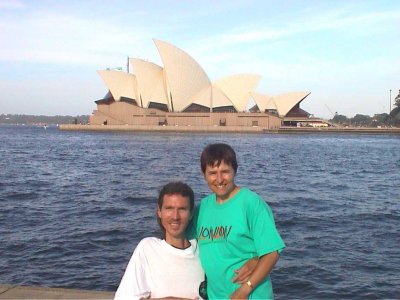
My wife and I have returned from a 6 week tour through Singapore and Australia and thought you might be interested in some feedback. I am permanently confined to a wheelchair through spinal muscular atrophy. For the purposes of travel evaluations please bear in mind that I am lightweight, my folding manual wheelchair is narrow (22 inches), and that we enjoy "walking" as much as possible, often covering over 12 miles per day. We generally "hit the streets" at around 09h30, and return to our accomodation after 21h00. The "access" discussed here is obviously from a wheelchair point-of-view.
- SINGAPORE

Bits and pieces of Singapore are wheelchair accessible. They've got ramped pavements, and some disabled toilets, but none of it really hangs together, and their public transport systems are complete no-no's (i.e. MRT and buses). We used cabs, but if you haven't got someone to lift you in and out then they won't work. What I mean by "hang together" is that, for example on Sentoza Island, the ground floor cable station level has a ramped entrance and disabled toilets, and the 1st floor cablecar station is ramped and accessible, but there is no way of getting between the ground floor and the 1st floor, other than up a long flight of stairs. The hotels seem to think an accessible room means a spacious room, and therefore have no concept of hand rails, roll-in showers, leg access under handbasins, etc. I can't comment on 5-star establishments. Singaporeans appear to believe that one uses a wheelchair much like a skateboard or bicycle, i.e. to get from A to B and then you get out of it and go the last couple of yards on foot. They really don't seem to understand the circumstance of "permanent confinement to a wheelchair". This is most noticeable when one books a day-trip. They will happily sit with you and discuss the days events, take your money, issue the tickets, etc, and then express amazement when you don't leap out your wheelchair to climb the stairs into the tour bus! This is no big deal to me, but it is worth bearing in mind when planning a trip, or dealing with hotels, transport, etc. It is important to understand that their culture pressurises them to never say "no", regardless of whether it is correct or not, they will always say "yes" to a question. If you ask whether a room is accessible the answer will always be "yes", even if there are stairs at the front door! This phenomenon is well documented, and is not intended as a criticism, but rather a pointer for first-time visitors.
Jurong Bird Park is mostly accessible (including the mono-rail), as is the Zoo, and the Night Safari (only one of the trams is accessible). Boat Quay, the business district, Chinatown, and Little India offer limited access even if you have assistance. Modern developments like the huge SunTec City (with its 4-storey high "Fountain of Wealth") are fully accessible, with modern toilets and inter-level lifts. Other attractions, depending on your tastes and size of wallet can include the Raffles Hotel, LamPaSat food court in the downtown business district (almost 100 stalls offering a wonderful selection of meals), the Satay Club, and Mustafa Centre (where else in the world could you buy food, toothpaste and a wig from the same kerbside vendor?!). The Indian Quarter is not wheelchair accessible, and the Chinese Quarter offers very limited access.
Sentoza Island, a type of seaside-resort-cum-Disney-experience, can be OK on a good day, but hugely frustrating on a bad one. We hit a bad one . . . with the mono-rail out of action, no accessible buses, no accessible trams, no accessible paths or trails, and construction on the beaches. We were left with only the roads as an option, and they can be very steep. We met a middle-aged couple on Sentoza where the husband was also wheelchair bound and they called it quits after an hour and headed back for the "mainland". Our feeling was that our time on Sentoza could have been better spent elsewhere.
Set against this we found the people to be very friendly and generally quite willing to assist here and there when needed. Singapore is wonderfully green and lush (it's not very far from the equator), with beautiful roads and parkways covered in blooming flowers and creepers. Service in stores and restaurants is excellent. Be ready to beome something of a local attraction. On more than one occasion a food vendor would serve us a delicious meal and then sit down nearby and watch us eat every morsel. Singapore comes in for a lot of criticism regarding its laws governing social behaviour, i.e. no spitting in the streets, no littering, no jay-walking, etc. Coming from South Africa where so many people seem to treat the country as a rubbish tip we found this to be somewhat unfair on Singaporeans, and found the clean and orderly state of their nation to be a real pleasure.
Would be go back to Singapore? . . . It was worth the first-time visiting experience, and the food was good, but getting around was a real mission.
- AUSTRALIA
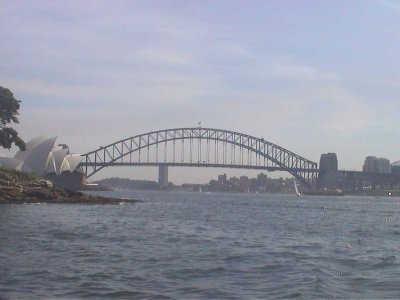
We toured, in order, . . . Melbourne, Tasmania, the Great Ocean Road, the Snowy Mountains, Canberra, the Blue Mountains, Sydney, Cairns, and Brisbane. We used Ansett Airlines for the main legs, four Hertz hire cars, ferrys, jetcats, cabs, and a train for transport.

Melbourne was warm and very walkable in terms of its topography and size. The Rialto Towers provide great city views by day or night (plus a pretty good movie on Melbourne). The SouthBank area (on the Yarra river) is a good place for eating and strolling, with a great vibe on a balmy summers evenings as city workers hold informal parties on the banks and watch friends rowing or cycling by. The SouthBank development extends a long way down into the Crown Casino complex for those seeking late night entertainment. Shoppers or bargain hunters might enjoy the daytime Victoria Street Market, a huge undercover collection of stalls selling clothing, gifts, food, and household items. Sportspersons will also appreciate, as we did, the Melbourne Cricket Ground, and the Tennis stadium (home of the Australian Open). The Chinese (some great restaurants) and Greek Quarters are also worth a visit although they can be tricky in places with a wheelchair. Melbourne pitches itself as the "cultural" centre of Australia, and we would probably agree with that.
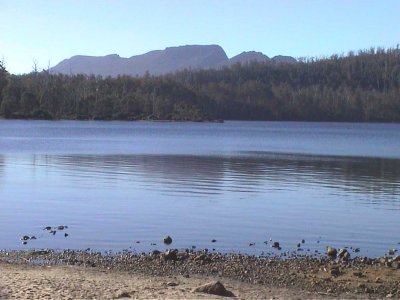
Tasmania was simple and relatively unspoilt, giving the impression of being one big rural community. We based ourselves in Hobart (only a one hour flight from Melbourne) for three days, taking day trips down to the Port Arthur penal colony museum, the Huon Valley and Hastings Forest, and Bonerong Animal Park. Mt.Wellington offers very good views over Hobart and its surrounds (lots of bays and inlets), and on a summers evening the Elizabeth Pier down in the harbour is a great place to stroll and try some local fish and chips. We then drove west to Russell Falls and Lake St.Claire, and on to Strahan / Queenstown for the all day Gordon River Cruise through the protected World Heritage Area which was a highlight. Then it was on to Cradle Mountain and Launceston (Cataract Gorge) in the north. We covered over 1000 miles in the hire car, it is not a small island! Although Tasmania obviously forms part of Australia, it really is a world apart . . . it has a farming community feel, there is no desire for designer brand clothing, and the only people talking on cellphones are the tourists. Their down-to-earth lifestyle is best demonstrated for us by the "honesty box" system which we saw in the Huon Valley. These are un-manned stalls, on the roadside, stocked with local fruit where one deposits your money in a tin can, and take your bag of apples, relying entirely on you to transact the deal honestly. It's a throwback to times gone by and incredibly refreshing to see.

Back on the mainland, the Great Ocean Road (west of Melbourne) rivals the USA's Highway 1 and hugs a stunning and jagged coastline for 100-odd miles. The Twelve Apostles is arguably its most well known rock formation, but don't miss out on London Bridge, The Grotto, and The Arch. Americans touring this part of the world might find it strange to see so many places named after their home country. We found it odd and wondered why the Australians felt a need to use names like "Bel Air", or "Monterey" when they quite clearly will never be related back to Aussie! We felt they needn't have outsourced the naming of the district, and should rather have used local naming conventions.
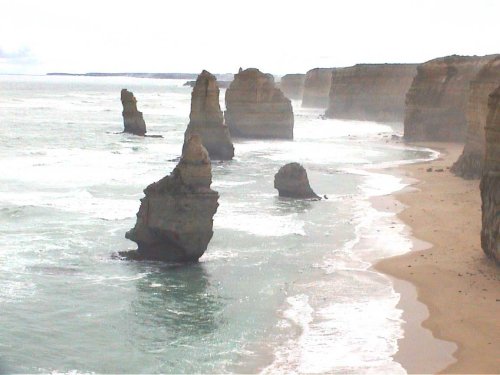
Turning inland and east the we drove inland to the Snowy Mountains, using the little town of Khancoban as our base. The weather turned wet and misty on us but we did manage the Yarrangobilly Caves (wheelchair accessible). One of the accessible caves has been kept in pristine condition (other than the mods for access) and this was quite a breath-taking sight with some of the most delicate and beautiful stalactite and stalactite formations imagineable. The guide, who can assist with the wheelchair, was excellent.
Continuing east . . . Canberra was spacious, pretty and interesting, with an excellent war memorial and museums. The Telstra Tower offers good elevated views of the city and surrounds, and the large Lake Burley-Griffin has accessible paths and walking trails in every direction. The city seems to be styled on WashingtonDC with the parliamentary building at one end of a long and wide pedestrian mall, and the war memorial at the other.
The Blue Mountains (Katoomba) were misty and rainy during our time but this seems to be perfectly normal weather conditions. We tried the SkyWay cablecar and the Zig-Zag Railway (both partially accessible). The Zig-Zag station is ramped and they've got a folding ramp onto the train but it is a bit narrow. The Three Sisters is the main attraction in Katoomba, and if its misty then the local iMAX theatre and its feature on the region is a good option.
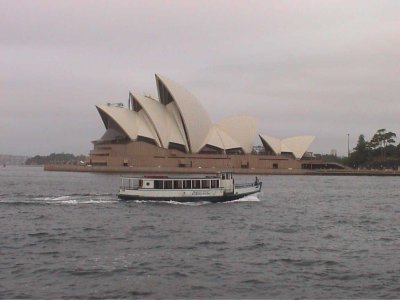
We had high expectations of Sydney but it let us down slightly, providing us with the worst accomodation of the trip (the YWCA) and some conflicting railway access. The 2000 Olympics are being held very far away from Sydney (you can't see the stadium from the Centrepoint AMP Tower), thank heavens, because the city is a traffic nightmare. We quickly learned that portions of the city are wheelchair no-go areas (terrible pavements and badly ramped), but others such as Circular Quay, Darling Harbour, Chinatown, the the botanical gardens are perfect. George and MacQuarie streets are "wheelchair" access routes running north-south down either side of the CBD, most of the other streets are probably best avoided unless you've got a good pusher! The state ferries in and around the harbour are accessible (some of the private ones are not), as are those out to Manly and they're great fun too. It is quicker, far easier, and more scenic to catch a ferry from Darling Harbour to Circular Quay than it is to try and "walk" it. One can enjoy a walk under the famous Harbour Bridge, through the beautifully restored "Rocks" district with its street markets and stores, across the front of Circular Quay, then around the even more famous Opera House, on around the seaward portion of the botanical gardens, past the well known Mrs MacQuarie's chair and end up passing the naval dockyard. If old buildings are your thing then try the Queen Victoria Building (the QVB) and of course the Rocks. One aspect of Sydney which was first-class was the choice of eating establishments . . . most notably yum-cha (dim sum) and sushi. Kam Sook's Shark Fin Restaurant at the entrance to Chinatown seats approx. 800 diners and is an experience not to be missed, but don't pass by an opportunity to stroll around the sprawling Paddy's Market two floors below at street level. We wanted to take in one of Sydney's famous beaches, and Manly won. We took the state ferry out, and the jetcat back, and did a whole lot of walking and relaxing in open air coffee bars in between.
Cairns was our springboard to the Kurunda tropical rain forests, and the Great Barrier Reef. Sunlover Cruises helped us achieve the goal to get out to the GBR and a genuinely helpful crew went out of their way to make it an enjoyable trip. Their jetcat has an onboard wheelchair toilet and accessible tables inside, though we preferred the feel of wind in our hair on the outer deck. Their semi-submersable sub and reef-based pontoon is accessible. The little town of Kurunda can be accessed via a SkyRail (7.5km accessible cable way, 70cm limit on wheelchair widths), or steam rail, each traversing the beautiful tropical rain forests and the spectacular Barron Falls. A brilliant route and well worth the whole day we gave it. The town of Cairns does not have much to it, it's really just a tourist base, but the sidewalk café's offer great places to relax after a hot day on the reef or in the forest!
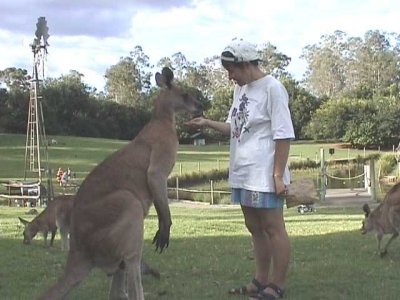
Brisbane is another river based city and was our base for doing the usual Aussie tourist activities of koala hugging, kangaroo feeding, and watching sheep shearing which we did at both the the Lone Pine Reserve and the Australian Woolshed Reserve. Brisbane's SouthBank development combining restaurants, swimming / walking / running / cycling facilities, open air auditoriums, the National Gallery, university, an inner-city beach!, open-air markets, etc is a great place to visit by day or night. The whole area is very accessible. The Brisbane River winds very lazily through the city and suburbs and hitching a ride on one of the commuter jetcat's and riding it to the end of its route, and back, proved to be a great way of seeing the area. They've also got a very nice botanical garden in the city (accessed by the jetcat if you wish) with a huge Banyan Vine (quite a sight). We also took a day out to enjoy Buderim and the seaside town of Maracoochydore (an hour north of Brisbane), all close to the Glass House Mountains.
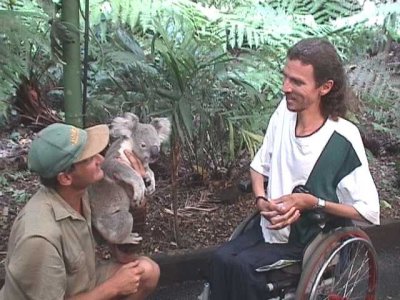
Our blood pressure rose ever so slightly on departure from Brisbane when the airport staff expected me to part company with my wheelchair in the arrivals hall over an hour before boarding and sit in one of their ghastly creations. It's a crazy system, which completely breaches their security (the wheelchair collection point is only 10 yards from an exterior door and they undergo no explosive or drug checks). It's also unacceptable for a wheelchair user. This was "rather clearly" explained to them, and they left me in my wheelchair until boarding.
The Aussies are a geniunely friendly nation and really live up to their favourite saying of "no worries mate!". Nothing is ever a worry and we were offered assistance by young and old alike. They are incredibly law abiding (they even leave disabled parking bays open for disabled people!) and the town and cities are clean and free of litter. Many of their public toilets looked more like doctor's surgery's they were so spotless! We could get used to living in a country where there seems to be no litter, where people are courteous, where the speed limit is followed, where people are trusting (we usually only paid for the accomodation on the mornings we left), and where the older generation seems to be able to afford to enjoy their retirement (there are a large number of retired Austalians touring).
Would we go back to Aussie? . . . you bet! . . . we're already planning the next trip to take in the west, central and north of the country . . . watch this space!
- NOTES
Not a fully wheelchair accessible hotel (although it is advertised as
such). Cramped bathrooms with low baths, low handbasins, and inaccessible
showers.
Very central location, ramped entrance, with elevator, but cramped bathroom.
Not wheelchair accessible, but a very spacious bedroom and bathroom.
The booking was done via the Best Western website.
Wheelchair accessible room, but two steps and a sprung swing door to
the admin / diningroom building. The booking was done via the Flag website.
Accessible room (very spacious), but very steep driveway down to road
level. The booking was done via the Flag website.
Not fully accessible (step up to front door), but spacious room.
Probably the best room of the trip, fully accessible, with an adjustable
shower chair, comode, parking outside front door, etc, etc. Admin and diningroom
building up one step with a sprung door. Booking done via the Internet.
A sad affair . . . a privately funded room conversion (according
to the door plaque) gone completely wrong. An example of how not to build
an accessible suite! Booking done via the Internet, which was also handled
badly (7 reminders before a confirmation!). We should have smelt a rat
right then.
An upstairs suite, but they shut-down the elevators at 20h00 !!
So we cancelled the booking and went across the road to the Best Western
and got an accessible room for A$50.
A time-warp hotel (back to the 60’s) with under cover parking, an
elevator, and partially accessible bathroom. For some unknown reason it
had 8 freestanding chairs in the room ?! Booking done via the Internet.
PLEASE NOTE : There appear to be fairly strict guidelines in Australia with respect to hotel’s / motel’s being able to advertise themselves as having wheelchair accessible rooms. This has its pro’s and con’s. The pro’s are that if an establishment says it is accessible then one can expect a high standard and good facilities (i.e. no surprises). The con’s are that not many establishments are able to offer this level of access, and those that do are expensive. Sydney’s YWCA does disprove this point, but then it seems to be an exception in more ways than one!
AIRLINES Singapore Airlines
The flight from Cape Town to Singapore was a rather deadly 14 hours!
(the flight back went a full 15.5 hours thanks to us having to skirt a
cyclone). The airline took care of us, but didn’t do anything special.
Their provision of individual tv screens (and the choice of approx 20 channels)
for each seat is something of a bonus and helps pass the time when the
discomfort gets bad. Watch out for Singapore Air’s “package deals”. They
will tell you a hotel is accessible when it is not (e.g. the
Peninsula, and the Excelsior), and they will sell you bus trips which you
cannot get on to. Rather do the land arrangements yourself.
Ansett Airlines
Ansett were our “domestic” carriers around Australia and did a good
job. Again, nothing special, but also no hassles.
It’s no reflection on the airlines (because it is not directly under their control), but passenger handling from airport to aircraft and visa versa is where we encountered the most problems. The airport wheelchairs are literally “wheelchairs from hell”, but more importantly they don’t work. I can’t believe that airport companies have not managed to come up with a decent aisle-chair. Their current models have no upper-back, or neck support, the armrests are too low to provide lateral support (and they remove them anyway when going down the aisles). Singapore Airline’s chairs use a solid board for the seat which is incredibly painful. Come on guys . . . a fixed frame chair, sling seat, high-back sling backrest, lap belt, chest belt . . . simple, easy, safe and cheap . . . it’s not rocket science?!
CAR HIRE Hertz
No hassles with Hertz at all . . . we used them in Tasmania (Toyota
Seca), along the Great Ocean Road (Nissan Pulsar), in Cairns (Nissan Pulsar),
and in Brisbane (Mazda Metro). All bookings were done on the Internet.
Enough room in the cars for the two of us, the luggage in the trunk, and
the wheelchair on the back seat. We always arranged to collect, and return,
the car from the airport building.
PUBLIC TRANSPORT Cab (taxi)
We used cabs in Singapore, Melbourne and Sydney without any problems.
The drivers were both willing to stop for the wheelchair, and to assist
in loading if needed. Indeed in Singapore, if one is able to transfer into
a cab, this is the best bet to get around.
Bus
These were a hassle in Singapore because they are not accessible at
all. At best one can try a mini-bus but transfers might prove difficult.
At worst one an be faced with a double-decker coach accessible only via
narrow, winding, and steep metal stairs. Didn’t see any accessible buses
in Australia although they are supposed to be there.
Ferry (jetcat)
We used ferries and jetcats often during the trip, both for harbour
cruises (in Sydney, Brisbane), scenic cruises (Tasmania, Sydney), and for
general day-to-day commuting. Strange as it may seem the ferries provided
us with the easiest form of transport, with no hiccups at all.
Train
We used the public train system only once in Australia, in Sydney,
to get to an outlying suburb. Whilst we did manage it (thanks to some willing
strongmen) was not really practical since the suburban destination station
could only be exited up a flight of stairs.
The INFORMATION CENTRE This network of information centres is a real bonus for travellers, and once we had cottoned on to looking out for the famous “i” it made arriving in new destinations a pleasure. They are usually positioned near the entry point of the town and are a valuable source of info on accomodation, things to do, notable sights, transport, dining, etc. Many of them offer an accomodation booking service, i.e. they will phone, book, and confirm accomodation right then and there while you wait. In Australia the “i’s” are staffed by volunteers and they are doing an excellent job.
EATING OUTFor us, part of the whole travelling experience is to try the local foods wherever possible. In Singapore this was a source of great pleasure since we enjoy the Asian style of cooking (dim sim, wontons, laksa, mee, stir-fry, etc). We also like the fact that most of the Chinese-style foods are cooked on-the-spot thereby providing a degree of freshness. Food courts (found in the basements of most large shopping complexes) are the way to go for sheer variety, but some of them can be inaccessible in the evenings.
In Melbourne we ate a lot of interesting and affordable Chinese meals as they have a strong and active community in the city. In Tasmania and along the Great Ocean Road we ate a lot of fish, inland we turned to local fare, in Canberra it was Asian again (a seriously big choice in the suburb of Dixons), Sydney was a veritable feast of Chinese and Japanese!, and Cairns was a mixture of fish and Chinese. Brisbane was pretty disappointing foodwise, with our choice of restaurants serving very old, very frozen, very fried, and very tasteless food for very high prices. The Australian food courts seem to only cater for the daytime traffic and close down in the later afternoon.
In Australia we “discovered” the phenomenon known as “the club”. These are the Retired Servicmen’s League (RSL) clubs located in virtually every town, no matter how big or small, offering dining, sporting and gambling facilities. If one is looking for a simple, hearty meal one need look no further. For AUS$25 a couple can expect to enjoy a meat-and-3-vegetable meal, washed down with a glass of house wine. Sometimes they can even surprise you and come up with a gem of a meal as they did for us in the little town of Seymour.
For those who enjoy eating outdoors, or picnic-ing, there is the Australian
“institution” of the "barbie" (or barbeque). It seems almost impossible
to drive 5 miles without coming across a neat, clean, and fully functioning
barbie alongside the road, or even in the town. You will also find them
in the national parks, game parks, public parks, and usually outside visitor
information centres.
IN CLOSING Based on past tour review feedback some folks find our comments
a bit forthright, but we say it the way we see it. We have repeatedly proved
that travelling in a wheelchair is neither daunting, nor limiting, and
hope our experiences will be of benefit to anyone who is may be planning
a tour of Singapore or Australia. Please do not hesitate to contact us
should you require any additional information.
Hilton Purvis & Loretta Jakubiec
eMail : [email protected]